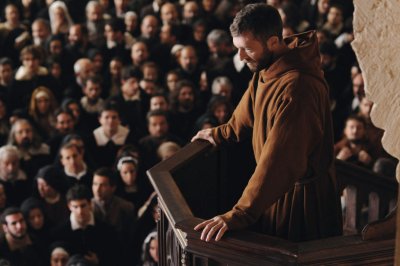Reviews - The Monk
The Monk
Reviewed By John Stakes

The Monk
When your lead character sports the name Ambrosio Capucino, was abandoned as a mewling infant outside the cloistered confines of a Spanish Catholic Monastery in 1595 thenceforth to grow into the most revered preacher in Castile, yet with no experience of the world outside, only a fool would bet against him losing his celibate status when his defences are breached.
Dominik Moll’s 2011 relentlessly gothic “The Monk” shown last Sunday eschewed any enlightened modern day opportunity to expose the hypocrisy and systemic abuse of the weak and vulnerable carried out by the catholic church (and other such institutions) over centuries, in favour of a highly stylised but reserved depiction of sexual predation and matricide by one of its foremost adherents when tempted by the Devil in feline form.
The only reason Ambrosio could be seen taking the high moral high ground at the film’s opening sermon was to show us just how far he was about to fall. Vixen proof he was not. Barely could the words “get thee behind me Satan” have been uttered in the time it took for temptation to personify itself Trojan horse style as the masked Matilda entered the Monastery posing as the novice friar Valero, and wormed her way into his affections. But it’s not long before, armed with a sprig of myrtle, he’s insinuating his way into the home (and bedroom) of the innocent beauty Antonia and her ill mother to rape the one and kill the other.
The testing of ecclesiastical faith is of course fertile cinematic territory. Ken Russell, Martin Scorsese, and many other distinguished directors over decades have indulged their cinematographers, make-up and costume departments, whilst testing the boundaries of various film classification boards.
Ambrosio’s tortured Faustian plight is plainly laughable to a modern, enlightened public, now repelled by monastic excesses which, even today, are still deliberately concealed from the outside world, and no amount of grovelling gravitas and tortured self-harming could mitigate Ambrosio’s behaviour whatever era may be selected for his self-gratification to be played out. Here, an ecclesiastical court eventually banishes him to the wilderness as an unrepentant apostate instead of handing him over to a people’s court for execution. So what are we to make of this 21st century take on 17th century monastic life?
Step forward the director himself. Moll co-wrote the screenplay. His approach apparently reflected the book’s main theme of the conflict between personal responsibility and the force of temptation when faced by an individual who has been brought up to lead a life of piety. No contest in the event. Visually Moll’s film vividly captured the guilt laden atmosphere generated by Ambrosio’s descent, and more than hinted at the cruel hidden world of monastic abuse. Moll also introduced scenes not found in the book including the religious procession with the monks bedecked with candles, their faces covered in wax to heighten the film’s symbolical and eerie feel. But what influences shaped his approach?
In interview Moll claims he was drawn to screen the then 19 year old Matthew Lewis’s notorious 1796 book (an injunction was taken out to prevent its publication in Britain) by the power of silent cinema, the dream-like quality of Hitchcock’s “Vertigo”, the artificiality of Powell and Pressburger’s “Black Narcissus” and the make-up in Ophul’s “Le Plaisir” in which a lusty bachelor at a dance turned out to be an elderly man whose face was covered in wax. Moll has the Devil’s disciple Matida pose as a horribly disfigured young masked friar.
A rich, doom laden score maintained the overall spookiness until almost the denouement of the film which proved to be somewhat of an abrupt conclusion as the banished Ambrosio enters into a pact with the Devil to release Antonia from her insanity.
The scenes were terrifically lit, the shadowed murky interiors contrasting with the striking brilliance of the sun-kissed great outdoors. But, in focussing heavily on symbolism with undertones of the supernatural, the film seemed strangely detached and never threw off its curio mantle. It was all style and image at the expense of character interaction, rather one-paced and oddly restrained by modern standards; a throwback to the “daring” art house cinema of the sixties and seventies revealing just how far cinema tastes have developed.
Geraldine Chaplin made an impressive but sadly brief appearance as a sadistic dominatrix of a prioress. Vincent Cassel succeeded in striking the right interplay between the lure of temptation and the recipient’s chronic inability to resist it which took Ambrosio in directions his self loathing was powerless to stop. But his overt gravitas at all times became ultimately tiresome.
The imagery however was impressive and our disbelief was suspended just about long enough to sustain the film to its conclusion. Moll’s gothic foray both tested and divided its large Keswick audience. Whatever else it was hard to ignore and justified its inclusion as the second of three French films in a fascinating season of world cinema.
Dominik Moll’s 2011 relentlessly gothic “The Monk” shown last Sunday eschewed any enlightened modern day opportunity to expose the hypocrisy and systemic abuse of the weak and vulnerable carried out by the catholic church (and other such institutions) over centuries, in favour of a highly stylised but reserved depiction of sexual predation and matricide by one of its foremost adherents when tempted by the Devil in feline form.
The only reason Ambrosio could be seen taking the high moral high ground at the film’s opening sermon was to show us just how far he was about to fall. Vixen proof he was not. Barely could the words “get thee behind me Satan” have been uttered in the time it took for temptation to personify itself Trojan horse style as the masked Matilda entered the Monastery posing as the novice friar Valero, and wormed her way into his affections. But it’s not long before, armed with a sprig of myrtle, he’s insinuating his way into the home (and bedroom) of the innocent beauty Antonia and her ill mother to rape the one and kill the other.
The testing of ecclesiastical faith is of course fertile cinematic territory. Ken Russell, Martin Scorsese, and many other distinguished directors over decades have indulged their cinematographers, make-up and costume departments, whilst testing the boundaries of various film classification boards.
Ambrosio’s tortured Faustian plight is plainly laughable to a modern, enlightened public, now repelled by monastic excesses which, even today, are still deliberately concealed from the outside world, and no amount of grovelling gravitas and tortured self-harming could mitigate Ambrosio’s behaviour whatever era may be selected for his self-gratification to be played out. Here, an ecclesiastical court eventually banishes him to the wilderness as an unrepentant apostate instead of handing him over to a people’s court for execution. So what are we to make of this 21st century take on 17th century monastic life?
Step forward the director himself. Moll co-wrote the screenplay. His approach apparently reflected the book’s main theme of the conflict between personal responsibility and the force of temptation when faced by an individual who has been brought up to lead a life of piety. No contest in the event. Visually Moll’s film vividly captured the guilt laden atmosphere generated by Ambrosio’s descent, and more than hinted at the cruel hidden world of monastic abuse. Moll also introduced scenes not found in the book including the religious procession with the monks bedecked with candles, their faces covered in wax to heighten the film’s symbolical and eerie feel. But what influences shaped his approach?
In interview Moll claims he was drawn to screen the then 19 year old Matthew Lewis’s notorious 1796 book (an injunction was taken out to prevent its publication in Britain) by the power of silent cinema, the dream-like quality of Hitchcock’s “Vertigo”, the artificiality of Powell and Pressburger’s “Black Narcissus” and the make-up in Ophul’s “Le Plaisir” in which a lusty bachelor at a dance turned out to be an elderly man whose face was covered in wax. Moll has the Devil’s disciple Matida pose as a horribly disfigured young masked friar.
A rich, doom laden score maintained the overall spookiness until almost the denouement of the film which proved to be somewhat of an abrupt conclusion as the banished Ambrosio enters into a pact with the Devil to release Antonia from her insanity.
The scenes were terrifically lit, the shadowed murky interiors contrasting with the striking brilliance of the sun-kissed great outdoors. But, in focussing heavily on symbolism with undertones of the supernatural, the film seemed strangely detached and never threw off its curio mantle. It was all style and image at the expense of character interaction, rather one-paced and oddly restrained by modern standards; a throwback to the “daring” art house cinema of the sixties and seventies revealing just how far cinema tastes have developed.
Geraldine Chaplin made an impressive but sadly brief appearance as a sadistic dominatrix of a prioress. Vincent Cassel succeeded in striking the right interplay between the lure of temptation and the recipient’s chronic inability to resist it which took Ambrosio in directions his self loathing was powerless to stop. But his overt gravitas at all times became ultimately tiresome.
The imagery however was impressive and our disbelief was suspended just about long enough to sustain the film to its conclusion. Moll’s gothic foray both tested and divided its large Keswick audience. Whatever else it was hard to ignore and justified its inclusion as the second of three French films in a fascinating season of world cinema.
Find A Film
Search over 1475 films in the Keswick Film Club archive.
Friends
KFC is friends with Caldbeck Area Film Society and Brampton Film Club and members share benefits across all organisations
Awards
Keswick Film Club won the Best New Film Society at the British Federation Of Film Societies awards in 2000.
Since then, the club has won Film Society Of The Year and awards for Best Programme four times and Best Website twice.
We have also received numerous Distinctions and Commendations in categories including marketing, programming and website.
 Talking Pictures
The KFC Newsletter
Talking Pictures
The KFC Newsletter
Links Explore the internet with Keswick Film Club


